Saturday, May 21, 2005
Silvered Æ antoninianus, Gallienus, Rome, Göbl 391r
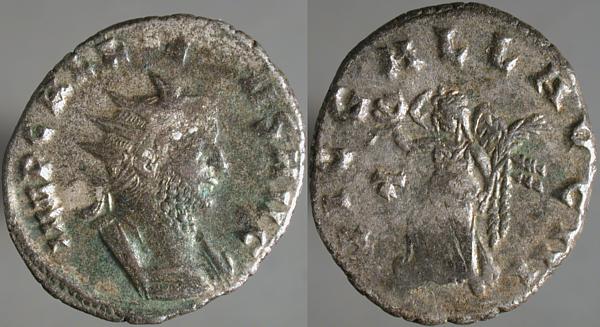
IMP GALLIENVS AVG, Radiate cuirassed bust right, one ribbon behind, one forward across shoulder | VIC GALL AVG III, Victoria advancing left, holding wreath left and palm over shoulder. T in left field.
Andreas Alfoldi convincingly argued in The Numbering of the Victories of the Emperor Gallienus and of the Loyalty of his Legions that this was part of a large issue immediately after Valerian's capture by Shapur was known at Rome, no earlier than October 260, and that this is the same victory celebrated on the final legionary issue of Mediolanum, there deemed the seventh dutifullness and fidelity of the legions, the victory over the usurper Regalianus.
Friday, May 20, 2005
Æ21, Antioch in Pisidia, Valerian, Lindgren I, 1250var
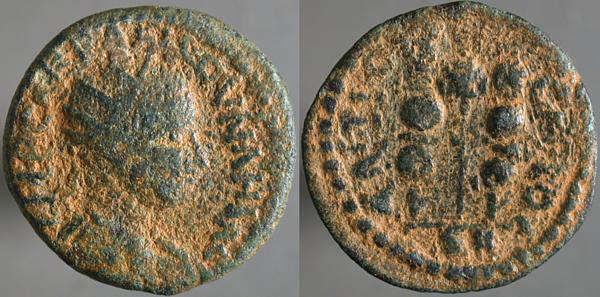
IMP CAERAS LL OVNAHI[..], Radiate draped cuirassed bust right | ANTIO[...]CL COC, Vexillum with eagle, head right, on top between two standards. SR in exergue.
Colony status was frequently granted to cities which had been selected to settle retired legionaries, where large numbers of soldiers were simultaneously retired. The Roman army spoke Latin, teaching new recruits if necessary, so that any Roman soldier could be understood by any other without local dialects interfering. Coins from colony cities such as Pisidian Antioch often have Latin legends.
Colony status and Latin legends on coins would likely be retained even if soldiers were no longer being retired there and the use of Latin declining. At this city the mint apparently wasn't able to teach even basic literacy to the die-engravers, who came to produce this sort of wierd alphabet soup.
Thursday, May 19, 2005
Silvered Æ antoninianus, Gallienus, Mediolanum, Göbl 1265f
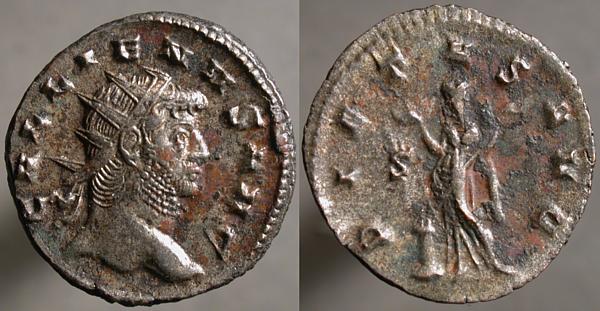
GALLIENVS AVG, Radiate head right | PIETAS AVG, Pietas standing facing, head left, drapery trailing from elbow, right, hand raised over flaming altar left. S in left field.
That there's an "S" in the left field marks this as an issue of the second officina, or workshop, of this mint, so it's a different coin than this
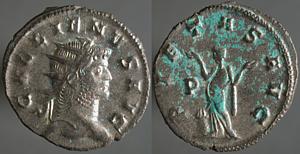 ,
,which is marked with a "P" for the first officina of that same mint.
Marking coins for officina was established, presumably, so that responsibility for irregularities would be easily fixed, which suggests that irregularities weren't uncommon.
Wednesday, May 18, 2005
Æ19, Seleukid Empire, Antiochos IX Kyzikenos, Sear Greek Coins 7170var (year)
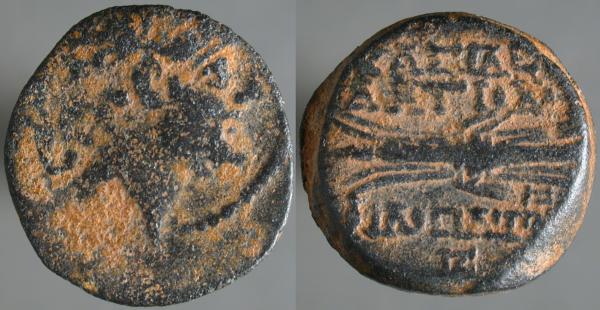
Laureate head right | Thunderbolt. ΒΑΣΙΛΕΩΣ ΑΝΤΙΟΧΟΥ above, ΦΙΛΟΠΑΤΟΣ over ΙΣ (dynastic year 210; 103-102 BCE) below.
Seleukos was one of Alexander's generals and established one of the most successful, longest-lasting kingdoms following Alexander's death. The empire into which that kingdom grew is admirably documented at this site.
Antiochos Kyzikenos was the son of Antiochos VII Euergetes (Sidetes) and Cleopatra Thea, and made war on his half-brother Antiochos VIII Gripos. He reigned over the part of the empire he could hold from 113 to 95 BCE.
Tuesday, May 17, 2005
Æ28, Anazarbus in Cilicia, Valerian, SNG von Aulock 5507
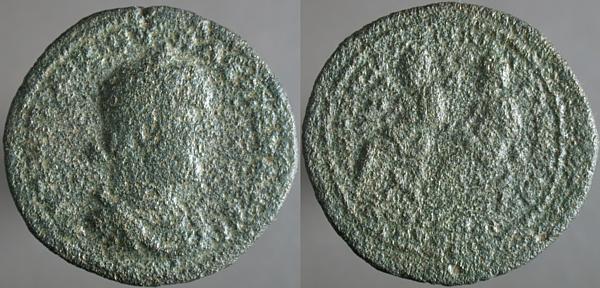
[AVT K Π·ΛIK·OVAΛEPIANOC CE], Laureate draped cuirassed bust right | [AVT K OVAΛEPIANOC ANAZAP BOC AVT ΓAΛΛI_HNOC], Valerian and Gallienus seated on curule chairs. AM in left field, K in right field.
I can almost make out a few letters here and there, but the truth is that the coin is illegible, with a thick patina and very rough surfaces. While the seller attributed it correctly, he used a catalog that I don't own and he didn't transcribe the legends.
The obverse wasn't hard to work out, since Anazarbus, like many provincial cities, minted few enough coins that the dies are individually recognizable, but I needed help from Helvetica, who maintains this useful site for collectors, to get the reverse.
Monday, May 16, 2005
supporting our men and women serving in Iraq and Afghanistan
The good folks at Operation AC have a new site.
Silvered Æ antoninianus, Gallienus, Mediolanum, Göbl 1093k

GALLIENVS AVG, Radiate head right, slight drapery on both shoulders | LAETITIA AVG, Laetitia standing facing, head left, holding wreath left, leaning on anchor right.
One way or another, Laetitia coins seem destined to embarrass me.
I originally thought this was from Rome, where it'd be cataloged as 479g, a bust that's not attested for the reverse. It wasn't until I'd photographed it and seen it and similar coins together that I realized that the emperor's face didn't look like a product of the Rome mint, but like one from the mint of Mediolanum. Göbl attests twelve examples of 1093k, so while this is an acceptable example of an uncommon coin, it's not quite all that I'd thought it.
Sunday, May 15, 2005
"two men from Chantry with a metal detector"
Æ tetradrachm, Alexandria, Gallienus, Emmett 3734(4)
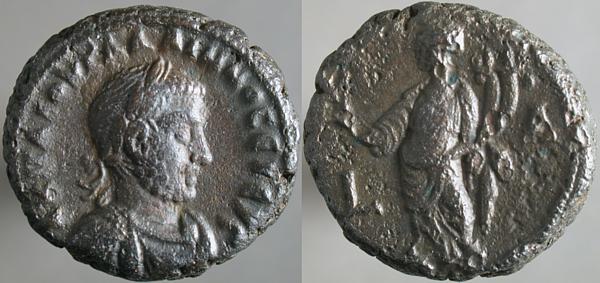
A K Π ΛI OV ΓAΛΛIHNOC EVEVC, Laureate draped cuirassed bust right | L_Δ, Homonia standing facing, head left, holding double cornucopias right, raised hand left. Regnal year across fields.
As I mentioned about a week ago, some provincial coins, like this from Roman Egypt, are explicitly dated. This dates to the fourth year of the reign of Gallienus (and his father), 256-257.

